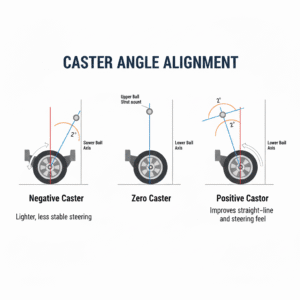
Caster Angle Alignment
Caster angle is one of the most critical suspension geometry measurements in modern vehicles, particularly European performance and luxury cars. Understanding **caster angle alignment** is key to maintaining the engineered stability and handling.. It represents the angle of the steering axis when viewed from the side of the vehicle. Proper caster angle ensures optimal steering response, straight-line stability, and tire wear characteristics that European manufacturers engineer into their vehicles.
Unlike camber and toe adjustments, caster primarily affects steering feel and high-speed stability rather than tire contact patch. German manufacturers like BMW, Mercedes-Benz, and Audi specify precise caster angles to deliver their signature driving dynamics.
Understanding Caster Angle Geometry
Positive Caster
Most modern European vehicles use positive caster (3° to 7°), where the steering axis tilts backward at the top. This configuration provides excellent straight-line stability, natural steering return, and improved high-speed handling.
Benefits: Enhanced stability, self-centering steering, better feedback, reduced driver fatigue on highways.
Negative Caster
Negative caster is rarely used in modern vehicles but may occur due to collision damage or worn suspension components. The steering axis tilts forward at the top, creating unstable handling characteristics.
Issues: Wandering at speed, lack of steering return, nervous handling, potential safety concerns.
Caster Split
The difference between left and right caster angles. European manufacturers typically specify maximum allowable splits of 0.5° to 1.0°. Excessive split causes vehicle pull and uneven steering effort.
Specification: Must stay within manufacturer tolerances to prevent directional instability.
Why European Cars Require Precise Caster Settings
European manufacturers engineer specific caster angles to deliver their signature driving characteristics. BMW’s sporty feel, Mercedes’ highway composure, and Audi’s quattro stability all depend on precise caster specifications. Even small deviations can compromise the refined handling these vehicles are known for.
Our alignment system measures caster to 0.01° accuracy, ensuring your European vehicle performs exactly as the engineers intended.
Caster Angle Effects on Vehicle Dynamics
High-Speed Stability
Positive caster creates a self-aligning torque that keeps the vehicle tracking straight, especially important for European vehicles designed for Autobahn speeds.
Steering Feel
Caster angle directly influences steering weight and feedback. More caster increases steering effort but provides better road feel and precision.
Cornering Dynamics
During turns, caster angle induces negative camber on the outside wheel, increasing the tire contact patch and improving grip.
Signs Your European Vehicle Needs Caster Adjustment
🔍 Vehicle Pull: The car drifts to one side on level roads, indicating caster split between left and right wheels.
🔍 Steering Wander: The steering feels loose or requires constant correction, suggesting insufficient positive caster.
🔍 Poor Steering Return: The steering wheel doesn’t naturally return to center after turns, a classic sign of caster issues.
🔍 Uneven Tire Wear: While caster primarily affects handling, improper settings combined with other alignment issues accelerate tire wear.
🔍 Post-Collision Concerns: Any front-end impact can alter caster angle by bending suspension components or shifting the subframe.
Caster Adjustment Methods for European Vehicles
Different European manufacturers use various methods for caster adjustment. BMW often uses eccentric bolts at the front control arm mounts, Mercedes-Benz may require shim adjustments, and some Audi models use slotted mounting points. Our technicians are trained in the specific procedures for each manufacturer.
Some vehicles require subframe repositioning or specialized aftermarket adjustment kits to achieve proper caster specifications, particularly after collision repair or when installing lowering springs. We stock manufacturer-approved adjustment hardware for all major European brands, ensuring a precise **European vehicle wheel alignment** every time.
Our European Vehicle Alignment Process
1. Comprehensive Inspection: We examine all suspension components, including control arms, ball joints, and subframe mounting points that affect caster angle.
2. Precision Measurement: Using manufacturer-specific alignment specifications, we measure caster angle with professional-grade equipment accurate to 0.01°.
3. Expert Adjustment: Our technicians use proper adjustment procedures for your specific European make and model, whether through eccentric bolts, shims, or strut tower adjustments.
4. Road Test Verification: Every alignment includes a test drive to verify steering feel, stability, and proper vehicle tracking.
